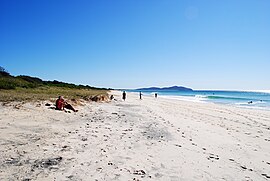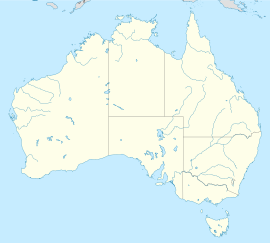Booti Booti National Park: Difference between revisions
| Line 31: | Line 31: | ||
==Fauna== |
==Fauna== |
||
Booti Booti National Park has had |
Booti Booti National Park has had 211 species of bird recorded within its limits.<ref name=environmentnsw2>{{cite web|url=http://www.environment.nsw.gov.au/NationalParks/parkWildlife.aspx?id=N0081 |title=Booti Booti National Park: Native animals |last=Office of Environment and Heritage|date=20 May 2013|work=Environment and Heritage |publisher=NSW Government|accessdate=3 June 2013}}</ref> |
||
==Activities== |
==Activities== |
||
Revision as of 14:18, 7 June 2013
| Booti Booti National Park Error: |state= not defined (help) | |
|---|---|
 A view of Seven Mile Beach, some of which is contained within Booti Booti National Park | |
| Coordinates | 32°14′40″S 152°32′36″E / 32.24444°S 152.54333°E |
| Established | 1992 |
| Area | 1,567 ha (3,870 acres)[1] |
Error: |type= not defined (help) | |
Booti Booti National Park is a national park in New South Wales, Australia, 282 kilometres (175 mi), by road, north-north-east of Sydney. The holiday town of Forster-Tuncurry lies immediately to the north.
History
The first European to inhabit the area was a Captain J. Gogerly who sailed from Forster to Sydney with loads of timber.[2] He and some of his family are buried in the park. Mining for mineral sands took place at Seven Mile Beach from 1969 to 1975, and at Elizabeth Beach from 1969 to 1970.[3] The park was declared a state recreation area from 30 September 1977, then a national park in 1992.[2]
Geography
Geographically, the National Park is made up of three hill complexes – the 224 m high Cape Hawke to the north, and 169 m high Booti Hill and 96 m high Charlotte Head in the southern end. The three areas are connected by low–lying estuarine and aeolian sands. The stretch of land between Cape Hawke and Booti Hill is around 10 km long and ranges between 400 m and 3.25 km wide. It separates Wallis Lake from the Ocean. Cape Hawke and Charlotte Head were once islands, which became joined to the mainland by built-up sand deposits.[3]
Flora
644 species of native plants have been recorded from Booti Booti National Park. This formed 47 distinct plant communities within the park boundaries. 16% of the park is classified as rainforest. Seven distinct wet sclerophyll forest and ten dry sclerophyll forest communities have been recorded.[3]
Four species recognised as threatened by the New South Wales Government occur within the park – these are Allocasuarina defungens, A. simulans, Chamaesyce psammogeton, Cynanchum elegans and Senna acclinis.[3]
103 exotic species have been recorded from the park. Bitou bush (Chrysanthemoides monilifera var. rotundata) has infested sand dunes and cliff areas,[3] having spread from nearby beach habitat.[4] Lantana camara infests the rainforest at Cape Hawke,[3] particularly disturbed habitat.[4] Madeira vine (Anredera cordifolia) and coast morning glory (Ipomoea cairica) are vines that grow over and smother native vegetation in the park.[3]
Fauna
Booti Booti National Park has had 211 species of bird recorded within its limits.[5]
Activities
Activities at Booti Booti National Park include hiking, swimming, birdwatching and, during winter, whale watching.[6] Camping sites are located at The Ruins, in the Booti Hill area at the park's southern end.[7] A lookout is located on top of Cape Hawke.[6]
See also
References
- ^ "Department of Environment Climate Change and Water Annual Report 2009-10". Department of Environment Climate Change and Water. November 2010: 274–275. ISSN 1838-5958.
{{cite journal}}: Cite journal requires|journal=(help) - ^ a b Office of Environment and Heritage (20 May 2013). "Booti Booti National Park: Culture and history". Environment and Heritage. NSW Government. Retrieved 3 June 2013.
- ^ a b c d e f g S.J. Griffith, R. Wilson and K. Maryott-Brown (2000). "Vegetation and flora of Booti Booti National Park and Yahoo Nature Reserve, lower North Coast of New South Wales" (PDF). Cunninghamia. 6 (3): 645–715.
- ^ a b Office of Environment and Heritage (20 May 2013). "Booti Booti National Park: Pest animals and weeds". Environment and Heritage. NSW Government. Retrieved 4 June 2013.
- ^ Office of Environment and Heritage (20 May 2013). "Booti Booti National Park: Native animals". Environment and Heritage. NSW Government. Retrieved 3 June 2013.
- ^ a b Office of Environment and Heritage (20 May 2013). "Booti Booti National Park". Environment and Heritage. NSW Government. Retrieved 4 June 2013.
- ^ Office of Environment and Heritage (20 May 2013). "Booti Booti National Park: Camping". Environment and Heritage. NSW Government. Retrieved 4 June 2013.

